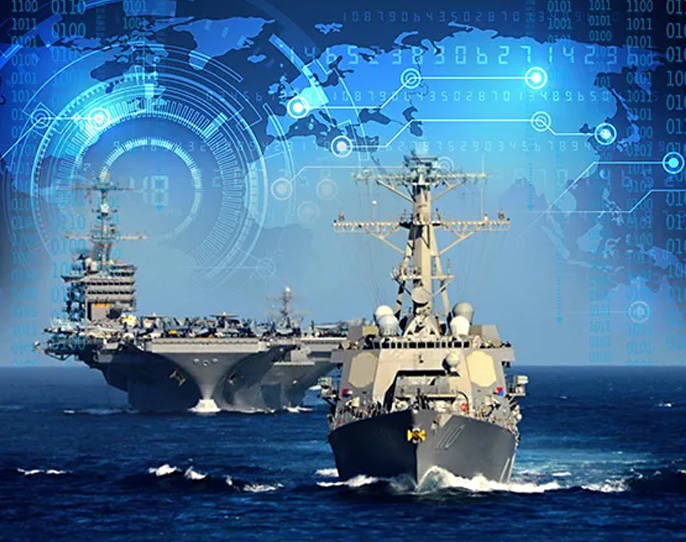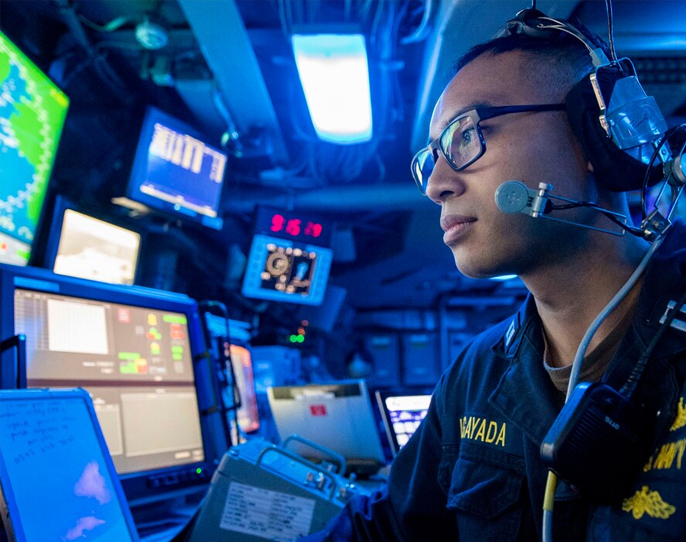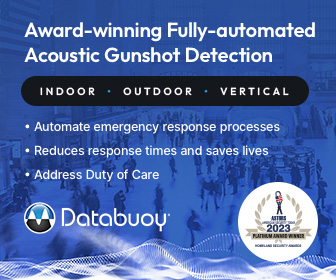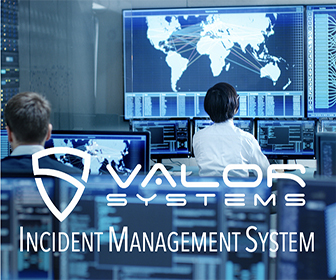
Guest Editorial by Chip Daniels, SolarWinds Vice President of Government Affairs
Technology is essential to the U.S. Navy, but never more so than when it is employed to assure command and control (C2).
Indeed, the U.S. military enjoys air, land, and sea superiority largely due to its Assured C2 capabilities, which it now considers a top operational priority.

However, rapid advances by other nations and evolving threats, including cyberattacks and information blockades, will require the Navy to make significant changes and improvements in how it will use and protect its current, planned, and forecasted information-based capabilities.
According to the Navy’s Information Dominance Roadmap:
“Assured C2 will require a more robust, protected, resilient, and reliable information infrastructure that undergirds the Navy’s overall information environment and allow uninterrupted worldwide communication between deployed units and forces ashore.”
Secure communication infrastructures and networks are vital to the success of military operations and their ability to fight.
As the Navy seeks to advance information dominance under Assured C2, here are three strategies designed to help.
-
Build a Resilient and Redundant Architecture
As the character of war changes and information warfare becomes a key weapon system deployed by U.S. adversaries, keeping Navy systems more secure requires building resilient and redundant architectures.
This priority was echoed in the new White House cyber implementation plan, which stresses developing and adopting secure by design and secure by default technologies to drive security and resilience.
(We’re in the middle of a security revolution. Sophisticated threat actors are becoming more active, organized sophisticated ransomware events are more common, and supply chain vulnerabilities continue to emerge. Today’s attacks show us risk mitigation takes organizational input and knowledge. Security and risk management should be part of everyone’s role. Learn about SolarWinds ongoing evolution to Secure by Design, the lessons the company has learned, and the actions they’ve taken. Courtesy of SolarWinds and YouTube.)
The plan also requires the DoD to update its department-wide cyber strategy.
As the plan takes shape, at the very minimum, building resilient architecture will require a twofold approach:
-
Measuring network availability or uptime:
-
Navy networks are extremely complex and spread over geographical locations, making pinpointing and resolving issues challenging. Responding and reacting to a sea of alerts or manually gathering network performance data from disparate sensors, systems, and IT teams in different locations and edge deployments can be time-consuming and costly.
-
Automated solutions are essential for near-real-time insights into network assets and rapid resolution of problems. Using modern monitoring tools, IT teams can monitor network availability stats using centralized dashboard views, avoid potential failures or deviations from acceptable standards, and ensure users can access IT resources and servers consistently.
-
Determining and prioritizing network bandwidth usage:
-
The second important factor is figuring out network bandwidth utilization. In military environments, every millisecond counts, and slow data transfer can delay critical operations.
-
Network bandwidth utilization monitoring is essential to finding the root cause of a slow network for quick resolution – whether it’s bandwidth-hogging applications or a group of users – even in hybrid environments.
(SolarWinds® Network Performance Monitor (NPM), created by network engineers for network engineers, is a complete monitoring solution designed to provide you with the tools you need to work smarter, improve visibility, and prevent downtime. See why SolarWinds is a worldwide leader in network monitoring. Courtesy of SolarWinds and YouTube.)
To ensure the force is networked in any environment – from line-of-sight operations to the tactical edge – IT teams also need the ability to quickly configure and allocate network bandwidth for high-priority naval applications, platforms, and users.
-
Have a Backup Plan in the Event of Failure
Achieving 100% network uptime in information-intensive combat environments and in the face of increasingly capable enemies equipped with anti-access and anti-denial defenses is challenging.
In the event of downtime or network degradation, performance can only be restored if military IT teams can isolate and identify slowdowns in network nodes and links before they impact operations.
For example, advanced network path analysis tools let IT teams visualize network paths hop-by-hop and see the exact location of an issue, even across hybrid environments.
(See how NetPath™, a feature of SolarWinds® Network Performance Monitor provides detailed hop-by-hop performance monitoring. Whether you are monitoring an internal network, or need visibility into the cloud, NetPath eases troubleshooting by allowing you to view critical paths from the user to the service. Courtesy of SolarWinds and YouTube.)
-
Observability
To assure C2 and maintain information security and resilience, observability is essential. Beyond traditional monitoring, observability correlates cross-domain analytics – from on-premises and multi-cloud environments – and actionable intelligence in a single pane of glass view.
Through end-to-end oversight of service delivery and component dependencies, IT teams across units and commands can break down silos and work seamlessly to understand their IT environments’ current and future state, including network, application, and database performance and security.

Plus, open platform observability solutions easily integrate into existing systems, networks, and operations – a key requirement stipulated by the Navy Joint Force Headquarters.
In short, observability provides for greater situational awareness, operational predictability, and resilient military operations.
Ready Systems ⇒ Ready Sailors and Marines
Assured C2 requires Navy information infrastructure that allows secure, worldwide communication between deployed units and forces ashore.
Ensuring the operational readiness, resilience, and security of vital network and data link services is paramount. The strategies outlined above play a crucial role in achieving this objective. Ultimately, prioritizing operational readiness enables and enhances overall mission readiness.
About the Author
Mr. Daniels joined SolarWinds, Inc. in September 2021 and has established the first Government Affairs function within the company.
Mr. Daniels is a proven leader with experience leading diverse organizations ranging in size from 16 to 22,000 people.

A former military officer, Mr. Daniels has mentored soldiers, sergeants, officers, and civilians in the Department of Defense (DoD) to achieve results in the most high-stress environments, with multiple combat deployments across the globe.
Before joining SolarWinds, Mr. Daniels completed a fellowship with the Science Applications International Corporation, (SAIC), Inc. as a member of the Government Affairs (GA) team.
In his final position in the Army, Mr. Daniels ran the team on the U.S. Army staff in the Pentagon that liaises with the U.S. Congress to craft the annual National Defense Authorization Act (the “defense bill”) to obtain the authorities and funding to support all Army policy and modernization programs, obtaining over $178 billion in 2020.
Previously, Mr. Daniels served as the Chief of Staff of all U.S. forces in Afghanistan, leading over 780 uniformed and civilian professionals in managing the $3.4 billion operating budget and all human resources, IT, and logistics functions for over 13,000 U.S. service members.
Additionally, he served as the Chief of Staff and COO of a U.S. Army Division of over 22,000 soldiers. Before his time in Afghanistan, he led the joint military team in the Pentagon that matched military resources with capability requirements for all U.S. military operations across the globe.
In this capacity, he led a cross-functional task force that assisted in developing the National Defense Strategy while developing the most significant change to military resource allocation in over ten years. After just two years, Congress appropriated over $580 million to support this change.
Mr. Daniels holds a B.S. from Virginia Tech, an MBA from Duke University, and a Masters of Strategic Studies from the U.S. Army War College. He proudly serves on the Board of Directors of the Virginia Tech Corps of Cadets Alumni, Inc.
SolarWinds is a leading provider of simple, powerful, secure IT management software built to accelerate customers’ digital transformation.
The company’s solutions provide organizations worldwide—regardless of type, size, or complexity—with a comprehensive and unified view of today’s modern, distributed, and hybrid network environments.
SolarWinds continuously engage with tech professionals (IT service and operations professionals, DevOps and SecOps professionals, and database administrators (DBAs)) to understand the challenges they face in maintaining high-performing and highly available IT infrastructures, applications, and environments.
(Whether you need to deliver a custom service across clouds, support physical hardware, optimize multiple database platforms, conduct security operations, or perform ticketing and service management, SolarWinds can unify all of this into one platform and make it much simpler to manage. All these things are interconnected and must work together seamlessly for your business to function at its best. SolarWinds is here to facilitate and encourage collaboration between teams, build consensus, and help solve problems faster. They’re always listening, always evolving, and always empowering their users. Courtesy of SolarWinds and YouTube.)
The insights gained from them, in places like the THWACK community, allow SolarWinds to address customers’ needs now and in the future.
With a focus on the user and commitment to excellence in end-to-end hybrid IT management, SolarWinds has established itself as a worldwide leader in solutions for observability, IT service management, application performance, and database management.
To learn more, please visit www.solarwinds.com.
SolarWinds Nominated in Eighth Consecutive ‘ASTORS’ Homeland Security Awards Programs

American Security Today’s Annual ‘ASTORS’ Awards is the preeminent U.S. Homeland Security Awards Program, and now in its Eighth Year, continues to recognize industry leaders of Physical and Border Security, Cybersecurity, Emergency Preparedness – Management and Response, Law Enforcement, First Responders as well as federal, state and municipal government agencies in the acknowledgment of their outstanding efforts to Keep our Nation Secure.
Learn More…
SolarWinds Next-Generation Build System Aligns with NIST SSDF































